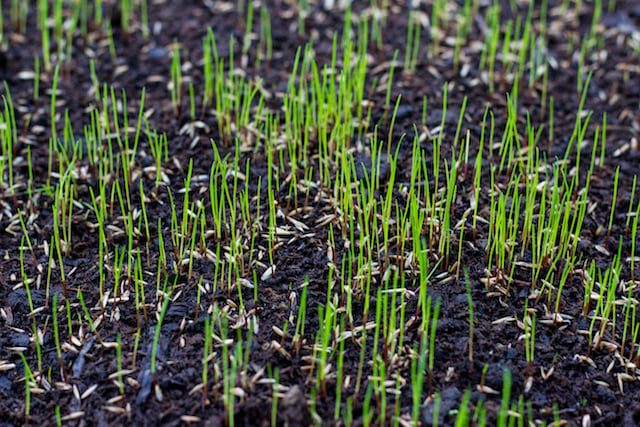Aeration and overseeding are often spoken about hand-in-hand, but do you have to overseed after aeration? The verdict is that the two lawn care tasks should be paired together, as aeration innately complements overseeding efforts.
The best place to start this conversation is with the importance of the grass seed germination rate.
The Higher The Grass Seed Germination Rate, The Better
Ideally, every grass seed spread across a lawn will sprout and grow. The reality is not all seeds will germinate, perhaps because of extreme heat, a lack of rain, or other environmental conditions.
The ratio between the number of grass seeds planted and the number that grows is referred to as the germination rate. For instance, if you planted 100 grass seeds and only 80 sprouted, the germination rate would be 80%.
While the average germination rate for many grass varieties falls within the 80% range, a range between 90%-95% is preferable. Lawn aeration can help move the needle in the right direction.
Lawn Aeration Sets the Optimal Foundation for Overseeding
The same tiny holes created by aeration not only allow water, air, and nutrients to circulate, but also provide nests for grass seeds. In combination with the increased level of contact with the soil, these so-called hiding spots create an ideal, protected space where grass seeds can germinate. This makes overseeding far more effective in clearing up bare patches, or simply evening out lawns.
While lawn aeration can take place in either the early spring or early fall (we recommend applications during both seasons), overseeding is best paired with the fall application. Between warm soil temperatures and cooler air temperatures, this is the time of the year when conditions are most favorable for seed germination.
Pairing Lawn Aeration with Other Lawn Care Best Practices
As we highlight the positive impact lawn aeration can have on the grass seed germination rate, it’s also worth noting how other lawn care measures can support these efforts.
Remove Debris
Leaves, rocks, and dead grass will act as a natural barrier between grass seed and soil. Clearing them out increases contact between the grass seed and the soil. It should lead to better seeding results. This same rule of thumb also applies to clumps of dead grass, which can actually weaken the grass seeds planted around it.
Keep Grass Seed Moist
All grass seeds require a certain degree of moisture to germinate. For optimal seeding conditions, water your lawn (and allow it to dry) before you plant seeds. Continue to lightly water the soil so that the top few inches remain moist, but not oversaturated. As the new grass plants become established, they will subsequently require less water.
Contact Lush Lawn for Your Aerating & Overseeding Needs
Lush Lawn is in the business of helping keep lawns green and beautiful. That’s why our list of lawn care services includes a fall lawn and restoration package that takes care of aerating and seeding, among other lawn maintenance tasks. The combination of these elements ensures you get the most from your investment and see the health of your lawn improve well into the future.
Ready to take the next step? Request a free quote from Lush Lawn today, and take advantage of our discounted rate!
